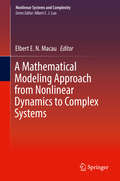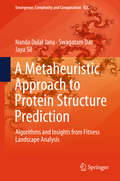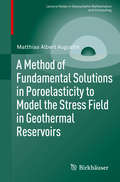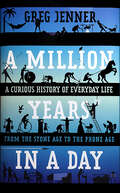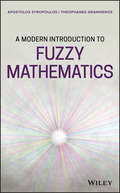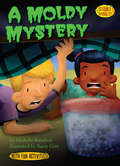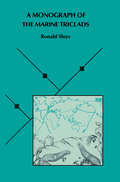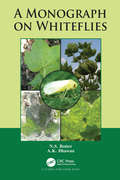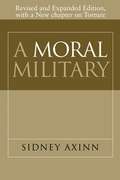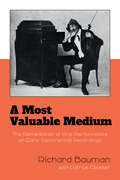- Table View
- List View
A Mathematical Introduction to Robotic Manipulation
by Richard M. Murray S. Shankar Sastry Zexiang LiA Mathematical Introduction to Robotic Manipulation presents a mathematical formulation of the kinematics, dynamics, and control of robot manipulators. It uses an elegant set of mathematical tools that emphasizes the geometry of robot motion and allows a large class of robotic manipulation problems to be analyzed within a unified framework. The foundation of the book is a derivation of robot kinematics using the product of the exponentials formula. The authors explore the kinematics of open-chain manipulators and multifingered robot hands, present an analysis of the dynamics and control of robot systems, discuss the specification and control of internal forces and internal motions, and address the implications of the nonholonomic nature of rolling contact are addressed, as well. The wealth of information, numerous examples, and exercises make A Mathematical Introduction to Robotic Manipulation valuable as both a reference for robotics researchers and a text for students in advanced robotics courses.
A Mathematical Modeling Approach from Nonlinear Dynamics to Complex Systems (Nonlinear Systems and Complexity #22)
by Elbert E. MacauThis book collects recent developments in nonlinear and complex systems. It provides up-to-date theoretic developments and new techniques based on a nonlinear dynamical systems approach that can be used to model and understand complex behavior in nonlinear dynamical systems. It covers symmetry groups, conservation laws, risk reduction management, barriers in Hamiltonian systems, and synchronization and chaotic transient. Illustrating mathematical modeling applications to nonlinear physics and nonlinear engineering, the book is ideal for academic and industrial researchers concerned with machinery and controls, manufacturing, and controls.· Introduces new concepts for understanding and modeling complex systems;· Explains risk reduction management in complex systems;· Examines the symmetry group approach to understanding complex systems;· Illustrates the relation between transient chaos and crises.
A Mathematical Perspective on Flight Dynamics and Control
by Andrea L'AfflittoThis brief presents several aspects of flight dynamics, which are usually omitted or briefly mentioned in textbooks, in a concise, self-contained, and rigorous manner. The kinematic and dynamic equations of an aircraft are derived starting from the notion of the derivative of a vector and then thoroughly analysed, interpreting their deep meaning from a mathematical standpoint and without relying on physical intuition. Moreover, some classic and advanced control design techniques are presented and illustrated with meaningful examples. Distinguishing features that characterize this brief include a definition of angular velocity, which leaves no room for ambiguities, an improvement on traditional definitions based on infinitesimal variations. Quaternion algebra, Euler parameters, and their role in capturing the dynamics of an aircraft are discussed in great detail. After having analyzed the longitudinal- and lateral-directional modes of an aircraft, the linear-quadratic regulator, the linear-quadratic Gaussian regulator, a state-feedback H-infinity optimal control scheme, and model reference adaptive control law are applied to aircraft control problems. To complete the brief, an appendix provides a compendium of the mathematical tools needed to comprehend the material presented in this brief and presents several advanced topics, such as the notion of semistability, the Smith–McMillan form of a transfer function, and the differentiation of complex functions: advanced control-theoretic ideas helpful in the analysis presented in the body of the brief. A Mathematical Perspective on Flight Dynamics and Control will give researchers and graduate students in aerospace control an alternative, mathematically rigorous means of approaching their subject.
A Mathematician's Apology
by G. H. HardyG. H. Hardy was one of this century's finest mathematical thinkers, renowned among his contemporaries as a 'real mathematician … the purest of the pure'. He was also, as C. P. Snow recounts in his Foreword, 'unorthodox, eccentric, radical, ready to talk about anything'. This 'apology', written in 1940, offers a brilliant and engaging account of mathematics as very much more than a science; when it was first published, Graham Greene hailed it alongside Henry James's notebooks as 'the best account of what it was like to be a creative artist'. C. P. Snow's Foreword gives sympathetic and witty insights into Hardy's life, with its rich store of anecdotes concerning his collaboration with the brilliant Indian mathematician Ramanujan, his idiosyncrasies and his passion for cricket. This is a unique account of the fascination of mathematics and of one of its most compelling exponents in modern times.
A Mathematics Boot Camp for Science and Engineering Students
by Ying MaMany students have difficulty applying mathematical techniques to solve problems in science and engineering, even after completing Calculus I and II. Students who are beginning the core coursework in their field of study often need additional guidance on practicing, learning, and improving their problem-solving skills for application. The objectives of A Mathematics Boot Camp for Science and Engineering Students are to offer a solution to this issue and are specifically designed to address common errors in mathematical problem-solving for undergraduate science and engineering students. Teaches readers how to apply math skills as they transition to coursework in their chosen field of study Includes strategies and recommendations for quick improvement in problem-solving skills Emphasizes the physical meanings of the problem, which helps students develop a deep understanding of their field of study Features a broad range of example problems with detailed and easy-to-follow solutions for students to learn problem-solving techniques and additional exercise problems for further practice and improvement Bridges the gap between the knowledge of mathematical techniques and the ability to apply those techniques to solve real-world problems This concise and practical text offers "basic training" in mathematical problem-solving skills for undergraduate students in science and engineering disciplines. A Solutions Manual is available to qualifying adopting professors.
A Matter Of Size: Triennial Review Of The National Nanotechnology Initiative
by National Research Council of the National AcademiesThe National Nanotechnology Initiative (NNI) was created in 2000 to focus and coordinate the nanoscience and nanotechnology research and development (R&D) activities being funded by several federal agencies. The purpose of the NNI is to marshal these research activities in order to accelerate responsible development and deployment of nanotechnology for economic benefit and national security. To take stock of the progress of the NNI, Congress, in P. L. 108-153, the 21st Century Nanotechnology Research and Development Act, directed the National Research Council to carry out a review of the program every three years. This report presents the results of the first of those reviews, which addresses the economic impact of nanotechnology developments and provides a benchmark of U.S. R&D efforts relative to those undertaken by foreign competitors. In addition, the report offers an assessment of the current status of responsible development of nanotechnology and comments on the feasibility of molecular self-assembly.
A Matter of Taste: A Farmers' Market Devotee's Semi-Reluctant Argument for Inviting Scientific Innovation to the Dinner Table (Exploded Views)
by Rebecca TuckerHow did farmer's markets, nose-to-tail, locavorism, organic eating, CSAs, whole foods, and Whole Foods become synonymous with “good food”? And are these practices really producing food that is morally, environmentally, or economically sustainable? Rebecca Tucker's compelling, reported argument shows that we must work to undo the moral coding that we use to interpret how we come by what we put on our plates. She investigates not only the danger of the accepted rhetoric, but the innovative work happening on farms and university campuses to create a future where nutritious food is climate-change resilient, hardy enough to grow season after season, and, most importantly, available to all—not just those willing or able to fork over the small fortune required for a perfect heirloom tomato. Tucker argues that arriving at that future will require a broad cognitive shift away from the idea that farmer's markets, community gardens, and organic food production is the only sustainable way forward; more than that, it will require the commitment of research firms, governments, corporations, and postsecondary institutions to develop and implement agriscience innovations that do more than improve the bottom line. A Matter of Taste asks us to rethink what good food really is.
A Metaheuristic Approach to Protein Structure Prediction: Algorithms And Insights From Fitness Landscape Analysis (Emergence, Complexity And Computation Ser. #31)
by Swagatam Das Nanda Dulal Jana Jaya SilThis book introduces characteristic features of the protein structure prediction (PSP) problem. It focuses on systematic selection and improvement of the most appropriate metaheuristic algorithm to solve the problem based on a fitness landscape analysis, rather than on the nature of the problem, which was the focus of methodologies in the past. Protein structure prediction is concerned with the question of how to determine the three-dimensional structure of a protein from its primary sequence. Recently a number of successful metaheuristic algorithms have been developed to determine the native structure, which plays an important role in medicine, drug design, and disease prediction. This interdisciplinary book consolidates the concepts most relevant to protein structure prediction (PSP) through global non-convex optimization. It is intended for graduate students from fields such as computer science, engineering, bioinformatics and as a reference for researchers and practitioners.
A Method of Fundamental Solutions in Poroelasticity to Model the Stress Field in Geothermal Reservoirs (Lecture Notes in Geosystems Mathematics and Computing)
by Matthias Albert AugustinThis monograph focuses on the numerical methods needed in the context of developing a reliable simulation tool to promote the use of renewable energy. One very promising source of energy is the heat stored in the Earth's crust, which is harnessed by so-called geothermal facilities. Scientists from fields like geology, geo-engineering, geophysics and especially geomathematics are called upon to help make geothermics a reliable and safe energy production method. One of the challenges they face involves modeling the mechanical stresses at work in a reservoir. The aim of this thesis is to develop a numerical solution scheme by means of which the fluid pressure and rock stresses in a geothermal reservoir can be determined prior to well drilling and during production. For this purpose, the method should (i) include poroelastic effects, (ii) provide a means of including thermoelastic effects, (iii) be inexpensive in terms of memory and computational power, and (iv) be flexible with regard to the locations of data points. After introducing the basic equations and their relations to more familiar ones (the heat equation, Stokes equations, Cauchy-Navier equation), the "method of fundamental solutions" and its potential value concerning our task are discussed. Based on the properties of the fundamental solutions, theoretical results are established and numerical examples of stress field simulations are presented to assess the method's performance. The first-ever 3D graphics calculated for these topics, which neither requiring meshing of the domain nor involving a time-stepping scheme, make this a pioneering volume.
A Methodology for Processing Raw LIDAR Data to Support Urban Flood Modelling Framework: UNESCO-IHE PhD Thesis
by Ahmad Fikri Bin AbdullahThe consequences of recent floods and flash floods in many parts of the world have been devastating. One way to improving flood management practice is to invest in data collection and modelling activities which enable an understanding of the functioning of a system and the selection of optimal mitigation measures. A Digital Terrain Model (DTM) provides the most essential information for flood managers. Light Detection and Ranging (LiDAR) surveys which enable the capture of spot heights at a spacing of 0.5m to 5m with a horizontal accuracy of 0.3m and a vertical accuracy of 0.15m can be used to develop high accuracy DTM but needs careful processing before using it for any application.This book presents the augmentation of an existing Progressive Morphological filtering algorithm for processing raw LiDAR data to support a 1D/2D urban flood modelling framework. The key characteristics of this improved algorithm are: (1) the ability to deal with different kinds of buildings; (2) the ability to detect elevated road/rail lines and represent them in accordance to the reality; (3) the ability to deal with bridges and riverbanks; and (4) the ability to recover curbs and the use of appropriated roughness coefficient of Manning‘s value to represent close-to-earth vegetation (e.g. grass and small bush).
A Migrant Family
by Larry Dane BrimnerWe all know what a supermarket is, but what is a farmer's market? It's a place where people gather together to sell products -- such as flowers, herbs, vegetables, fruit, and more -- that they have grown or produced. Through lively text, readers will meet two families -- one Hmong American and the other German American -- as they work hard to prepare for a busy market season.
A Mill Should Be Build Thereon: An Early History of the Todmorden Mills
by Eleanor DarkeIt is difficult for Todmorden Mills Museum visitors to imagine that this site so close to the busy Don Valley Parkway was once home to an important mill. As early as 1793 Governor Simcoe recognized the industrial potential of this portion of the Don River. By 1795 Skinner’s sawmill was under construction, initiating an era of technological development that spread beyond the valley of the Don into what was then Muddy York. Today, Todmorden serves to remind us of Toronto’s industrial heritage and the spirit of the time. This invaluable local history confirms the significance of early mills and later factories along the Don River and recognizes the roles played by Timothy Skinner, Parshall Terry, George Playter, William Helliwell and other settlers and entrepreneurs of Governor John Graves Simcoe’s time and beyond. Eleanor Darke, assisted by Ian Wheal, presents us with an informative account of the people, their lives and their creative influence.
A Million Years in a Day: A Curious History of Everyday Life from the Stone Age to the Phone Age
by Greg JennerWho invented beds? When did we start cleaning our teeth? How old are wine and beer? Which came first: the toilet seat or toilet paper? What was the first clock?Every day, from the moment our alarm clock wakes us in the morning until our head hits our pillow at night, we all take part in rituals that are millennia old. Structured around one ordinary day, A Million Years in a Day reveals the astonishing origins and development of the daily practices we take for granted. In this gloriously entertaining romp through human history, Greg Jenner explores the gradual—and often unexpected—evolution of our daily routines.This is not a story of wars, politics, or great events. Instead, Jenner has scoured Roman rubbish bins, Egyptian tombs, and Victorian sewers to bring us the most intriguing, surprising, and sometimes downright silly historical nuggets from our past.Drawn from across the world, spanning a million years of humanity, this book is a smorgasbord of historical delights. It is a history of all those things you always wondered about—and many you have never considered. It is the story of your life, one million years in the making.
A Mind at Play: How Claude Shannon Invented the Information Age
by Jimmy Soni Rob GoodmanWinner of the Neumann Prize for the History of Mathematics "We owe Claude Shannon a lot, and Soni & Goodman&’s book takes a big first step in paying that debt." —San Francisco Review of Books "Soni and Goodman are at their best when they invoke the wonder an idea can instill. They summon the right level of awe while stopping short of hyperbole." —Financial Times "Jimmy Soni and Rob Goodman make a convincing case for their subtitle while reminding us that Shannon never made this claim himself." —The Wall Street Journal &“A charming account of one of the twentieth century&’s most distinguished scientists…Readers will enjoy this portrait of a modern-day Da Vinci.&” —FortuneIn their second collaboration, biographers Jimmy Soni and Rob Goodman present the story of Claude Shannon—one of the foremost intellects of the twentieth century and the architect of the Information Age, whose insights stand behind every computer built, email sent, video streamed, and webpage loaded. Claude Shannon was a groundbreaking polymath, a brilliant tinkerer, and a digital pioneer. He constructed the first wearable computer, outfoxed Vegas casinos, and built juggling robots. He also wrote the seminal text of the digital revolution, which has been called &“the Magna Carta of the Information Age.&” In this elegantly written, exhaustively researched biography, Soni and Goodman reveal Claude Shannon&’s full story for the first time. With unique access to Shannon&’s family and friends, A Mind at Play brings this singular innovator and always playful genius to life.
A Modal Approach to the Space-Time Dynamics of Cognitive Biomarkers (Synthesis Lectures on Biomedical Engineering)
by Tristan D. Griffith James E. Hubbard Jr. Mark J. BalasThis book develops and details a rigorous, canonical modeling approach for analyzing spatio-temporal brain wave dynamics. The nonlinear, nonstationary behavior of brain wave measures and general uncertainty associated with the brain makes it difficult to apply modern system identification techniques to such systems. While there is a substantial amount of literature on the use of stationary analyses for brain waves, relatively less work has considered real-time estimation and imaging of brain waves from noninvasive measurements. This book addresses the issue of modeling and imaging brain waves and biomarkers generally, treating the nonlinear and nonstationary dynamics in near real-time. Using a modal state-space formulation leads to intuitive, physically significant models which are used for analysis and diagnosis.A Modal Approach to the Space-Time Dynamics of Cognitive Biomarkers provides a much-needed reference for practicing researchers in biomarker modeling leveraging the lens of engineering dynamics.
A Modern Course in Aeroelasticity (Solid Mechanics and Its Applications #264)
by Earl H. DowellThis book is the sixth edition. It is suitable for one or more courses at the advanced undergraduate level and graduate level to cover the field of aeroelasticity. It is also of value to the research scholar and engineering practitioner who wish to understand the state of the art in the field. This book covers the basics of aeroelasticity or the dynamics of fluid–structure interaction. While the field began in response to the rapid development of aviation, it has now expanded into many branches of engineering and scientific disciplines and treats physical phenomena from aerospace engineering, bioengineering, civil engineering, and mechanical engineering in addition to drawing the attention of mathematicians and physicists. The basic questions addressed are dynamic stability and response of fluid structural systems as revealed by both linear and nonlinear mathematical models and correlation with experiment. The use of scaled models and full-scale experiments and tests play a key role where theory is not considered sufficiently reliable.
A Modern Herbal
by Alys FowlerTHE BEST GARDENING BOOKS OF THE YEAR - GARDENS ILLUSTRATED'Informative and enthusiastic' i PaperPLANT-BASED MEDICINE FOR A CALMER, HEALTHIER LIFE It's easy to turn to the pharmacy when we're stressed, sick or feeling under the weather, but what if you turned to your garden instead?In this accessible and easy to use manual, horticultural expert, former Gardener's World presenter and Guardian columnist, Alys Fowler, shows how to take control of your health by adopting a more natural lifestyle. For thousands of years, people who had no access to clinical medicine knew how to boost their well-being by using the ingredients they found in plants. Herbs are the people's medicine; often freely available and abundant, they are ready and waiting to be plucked from around you to soothe and heal your body and mind. With guides for how to use and grow over 100 herbs - for example how to use fennel for indigestion, camomile for anxiety and nettle for hayfever - you'll soon be heading into the garden, rather than opening the medicine cabinet. Offering a fusion of botanical, practical, cultural and historical information, A Modern Herbal reveals how common herbs are the simple, cleansing way to better health and happiness.AS SEEN IN THE GUARDIAN'An important and accessible herbal for the 21st century . . . For anyone delving into herbs for the first time or those who want to broaden their herbal repertoire in the garden and home, this book is much needed' Gardens Illustrated
A Modern History of Materials: From Stability to Sustainability
by M. Grant NortonWhat could the ancient Egyptians tell us about 3D printing? How can we make lithium-ion batteries greener and more sustainable? Which materials will form the heart of future quantum computers?Plastic films, glass optical fibers, silicon crystals, and more — this book is about the history of the materials that have rapidly transformed our society over the last century and their role in the major global challenges of the future. From metal alloys ushering in a new age of industry to advanced materials laying the atomic brickwork of the Digital Revolution, the book examines the societal impact of the modern materials revolution through the twin lenses of stability and sustainability.Why aren’t maglev trains mainstream? Whatever happened to graphene and carbon nanotubes? The book also looks at the unmet promises of some of the most exciting — and hyped — technologies in recent decades — superconductivity and nanotechnology. The final chapter reviews our history of materials usage, the increasing demand for many critical raw materials, and addresses the upcoming new challenges for creating a circular economy based on reusing and recycling materials.
A Modern Introduction to Fuzzy Mathematics
by Apostolos Syropoulos Theophanes GrammenosProvides readers with the foundations of fuzzy mathematics as well as more advanced topics A Modern Introduction to Fuzzy Mathematics provides a concise presentation of fuzzy mathematics., moving from proofs of important results to more advanced topics, like fuzzy algebras, fuzzy graph theory, and fuzzy topologies. The authors take the reader through the development of the field of fuzzy mathematics, starting with the publication in 1965 of Lotfi Asker Zadeh's seminal paper, Fuzzy Sets. The book begins with the basics of fuzzy mathematics before moving on to more complex topics, including: Fuzzy sets Fuzzy numbers Fuzzy relations Possibility theory Fuzzy abstract algebra And more Perfect for advanced undergraduate students, graduate students, and researchers with an interest in the field of fuzzy mathematics, A Modern Introduction to Fuzzy Mathematics walks through both foundational concepts and cutting-edge, new mathematics in the field.
A Moldy Mystery (Science Solves It!)
by Michelle KnudsenSolve kid-sized dilemmas and mysteries with the Science Solves It! series. These fun books for kids ages 5–8 blend clever stories with real-life science. Why did the dog turn green? Can you control a hiccup? Is that a UFO? Find the answers to these questions and more as kid characters dive into physical, life, and earth sciences. It's gross! It's aliiiive! After a moldy mix-up, Jeff has to do the unthinkable—and fast! Books in this perfect STEM series will help kids think like scientists and get ahead in the classroom. Activities and experiments are included in every book! (Level Two; Science topic: Mold)
A Monograph of the Marine Triclads
by R. SluysA biosystematic study of one of three major groups of planarian flatworms, the marine triclads, or Maricola.
A Monograph on Whiteflies
by N.S. Butter A.K. DhawanIn all, 1550 species of whiteflies have been identified. The rapid spread of Bemisia tabaci has occurred throughout the globe and it is regarded as the most notorious species. It is a complex species known to contain many biotypes namely, New World (Biotype -A), B-biotype MEAM1 (Biotype-B or Bemisia argentifolii, and MED (Biotype-Q) depending upon the geographical location. The complete information on the bio-ecology of important species along with the feeding mechanism has been presented in this book. The use of modern techniques of identification has added more biotypes considering the variations in host range, species of endosymbionts, virus transmission efficiency, and resistance to pesticides. The resistance and resurgence due to pesticides has been discussed in the monograph. The information on economic thresholds for judicious use of pesticides or release of natural enemies against whiteflies has been quoted in this compilation The pest control methods, namely chemical, cultural measures, biocontrol agents, resistant varieties, and mechanical devices have been elaborated on. Based on the availability of information the integrated model has been suggested to contain the whitefly menace under different situations. Considering the key factors responsible for the outbreak of whiteflies, a sound system of IPM has been formulated. The book also contains the use of semiochemicals and biotechnological tools likely to gain momentum in the future.
A Moral Military, Revised and Expanded Edition
by Sidney AxinnShould a good soldier ever disobey a direct military order? Are there restrictions on how we fight a war? What is meant by 'military honor', and does it really affect the contemporary soldier? Is human dignity possible under battlefield conditions? Sidney Axinn considers these basic ethical questions within the context of the laws of warfare and answers 'yes' to each of these questions. In this study of the conduct of war, he examines actions that are honorable or dishonorable and provides the first full-length treatment of the military conventions from a philosophical point of view. Axinn gives a philosophical analysis of the 'Laws of Warfare' as found in the Hague and Geneva Conventions, which have been agreed to by almost every nation in the world. The aims of his study are to establish a basic twentieth-century framework for moral military action and to assist military personnel in analyzing their won professional ethic.Stating that moral reasoning is required by people in military uniform in a wide variety of situations, the author examines the question of the limits of military obedience. Axinn argues for the seriousness of the concept of military honor but limits honorable military activity by a strict interpretation of the notion of war crime. Major chapters deal with military honor, prisoners of war, spying, war crimes, the dirty-hands theory of command, nuclear weapons, terrorism, and covert operations. This philosophical study of the line between honorable and dishonorable military action cautions that in compliance with the war conventions professional military personnel and knowledgeable civilians must not lose their moral nerve nor abandon honor to satisfy immoral political requests. Author note: Sidney Axinn is Professor of Philosophy at Temple University.
A Moral Technology: Electrification as Political Ritual in New Delhi
by Leo ColemanIn India over the past century, electrification has meant many things: it has been a colonial gift of modern technology, a tool of national integration and political communication, and a means of gauging the country's participation in globalization. Electric lights have marked out places of power, and massive infrastructures have been installed in hopes of realizing political promises. In A Moral Technology, the grids and wires of an urban public utility are revealed to be not only material goods but also objects of intense moral concern. Leo Coleman offers a distinctive anthropological approach to electrification in New Delhi as more than just an economic or industrial process, or a "gridding" of social and political relations. It may be understood instead as a ritual action that has formed modern urban communities and people’s sense of citizenship, and structured debates over state power and political legitimacy.Coleman explores three historical and ethnographic case studies from the founding of New Delhi as an imperial capital city, to its reshaping as a national capital for post-independence India, up to its recent emergence as a contemporary global city. These case studies closely describe technological politics, rituals, and legal reforms at key moments of political change in India, and together they support Coleman’s argument that ritual performances, moral judgments, and technological installations combine to shape modern state power, civic life, and political community.
A Most Valuable Medium: The Remediation of Oral Performance on Early Commercial Recordings
by Richard BaumanBetween 1895 and 1920, the United States saw a sharp increase in commercial sound recording, the first mass medium of home entertainment. As companies sought to discover what kinds of records would appeal to consumers, they turned to performance forms already familiar to contemporary audiences—sales pitches, oratory, sermons, and stories. In A Most Valuable Medium, Richard Bauman explores the practical problems that producers and performers confronted when adapting familiar oral genres to this innovative medium of sound recording. He also examines how audiences responded to these modified and commoditized presentations. Featuring audio examples throughout and offering a novel look at the early history of sound recording, A Most Valuable Medium reveals how this new technology effected monumental change in the ways we receive information.

